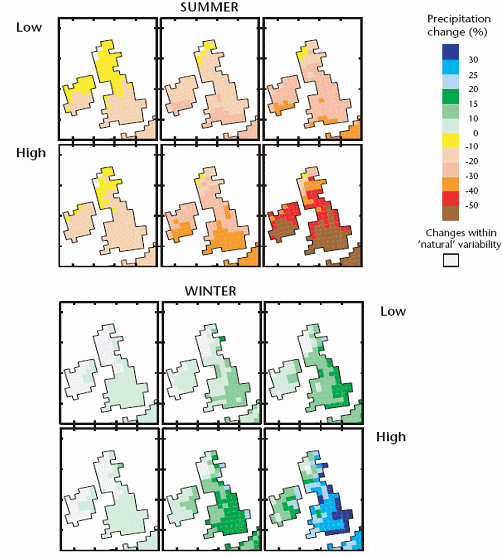Approved Document H, amended in 2002, covers both foul and rainwater drainage, waste water treatment systems and cesspools and solid waste storage.
The data we have used in the past, and continue to use to design our drainage systems has changed little, if at all over the past forty years. Indeed the frequency of exceptional events uses data collected over the past century. Buildings continue to be designed on historic data which is not necessarily applicable to the future.
Some of the building work carried out today will still be in use in up to 100 years time – the climate will however change over the next 100 years.

Looking at the above charts, in less than 75 years time, with a low level of predicted change, summers could be up to 30% drier, with winters up to 20% wetter. If we consider the high level of predicted change, the summers could be more than 50% drier and winters more than 30% wetter. What effect will this have on our drainage systems? Will we experience increased silting up of drains during summer because there isn’t enough flow through them to maintain self cleansing velocities, followed by more flooding during winter because our systems have been designed using historic data? Not only are the winters going to be wetter, the pattern of rainfall is going to change as well. We are likely to get more intense downpours and for longer periods than we used to experience. This will further test our surface water drainage systems. Surely we should be designing on the basis of what is likely to happen, not what has already occurred.
For foul drainage, recent water conservation proposals, including legislation, have led to a reduction in the quantities of water available to transport waste into the sewer, and have had a major impact on the hydraulics associated with the transportation of solids in near horizontal drains in buildings. Current design practice, based on statistical methods, leads to oversized systems. The Code for Sustainable Homes, published in December 2006 further impacts on the problem by encouraging the use of fittings that operate on less water. The Code will form one source for future changes to the Building Regulations, some of these will impact on Part H. Although it does not apply to industrial or commercial development, I believe when its proposals are incorporated into the Building Regulations many of them will apply to all buildings.
Some of the Code’s proposals will help alleviate the dangers of flooding, whilst others could present a problem for our foul water systems. It proposes:
- A reduction of surface water run-off from both the sites and roofs.
- Development in areas of low annual probability of flooding.
- That run-off rates and annual volumes of run-off will be no greater, or preferably a lot lower than the previous conditions for the development site. These can be achieved by, e.g. the introduction of soakaways and permeable paving.
- Reduced daily personal water usage.
- Denser development.
Although guidance on some of the above items is available in Approved Document H, their use is not always currently compulsory. Paragraph 0.2 of AD H3 states ‘Methods of drainage other than connection to a public surface water sewer are encouraged where they are technically feasible.’ We may see future editions stating that, where technically feasible, methods of drainage other than connection to a public service water sewer are compulsory.
Whilst it is not possible to eliminate the risk of flooding altogether, many practical steps can be taken to reduce the cost of flood damage repairs and speed up recovery times. The Governments publication ‘Preparing for floods’ gives advice on flooding and is applicable to existing property owners and new development.
NBS is the official publisher of the Approved Documents. A searchable electronic version of the Approved Documents with enhanced diagrams can be accessed by subscription to www.thenbs.com/buildingregs ![]() .
.

